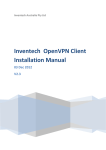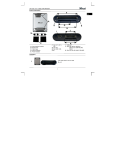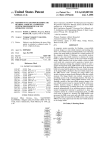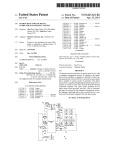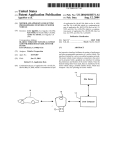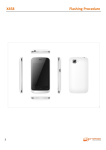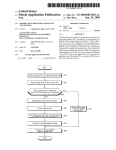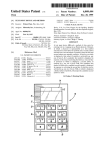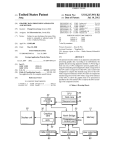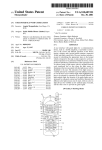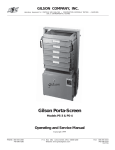Download System for protecting BIOS from virus by verified system
Transcript
US006591362B1 (12) United States Patent (10) Patent N0.: Li (54) US 6,591,362 B1 (45) Date of Patent: Jul. 8, 2003 SYSTEM FOR PROTECTING BIOS FROM 5,844,986 A * 12/1998 Davis .......................... .. 380/4 VIRUS BY VERIFIED SYSTEM MANAGEMENT INTERRUPT SIGNAL 5,881,151 A 6,009,524 A * 3/1999 Yamamoto ................... .. 380/9 * 12/1999 Olarig et al. ...... .. 713/200 SOURCE 6,026,016 A * 6,292,012 B1 * _ . . . (75) Inventor‘ Yung F“ L"Ta1pe1(TW) (73) Assigneez Inventech Corporation, Taipei (TW) (*) Notice: 2/2000 Ga??en ...... .. 9/2001 Yeh et al. Davis et al. 365/185.04 ......... .. 326/8 6,401,208 B2 * 6/2002 6,408,387 B1 * 6/2002 Wells .......................... .. 713/1 .............. .. 713/193 * 6,510,521 B1 1/2003 Albrecht et al. .......... .. 713/193 * cited by examiner Subject to any disclaimer, the term of this _ Primary Examwer—Thomas Lee U_S_C_ 154(k)) by 0 days Assistant Examzner—Chun Cao (74) Attorney, Agent, or Firm—Birch, SteWart, Kolasch & (21) Appl. NO.Z 09/496,358 (22) Filed: Feb. 2, 2000 (51) Blrch’ LLP (57) Int Cl 7 ' ABSTRACT G06F 15/177, G06F 9 /2 4, This invention discloses a method for preventing BIOS from ’G06F 12/14; viruses. It mainly uses the necessary signal produced When l """""""""""" " _ _ (52) US. Cl. ............................. .. 713/1, 713/2, (58) Fleld of Search """"""""" _ ?ash memory is Written to generate a system management interrupt (SMI). Therefore, when a Writing action Occurs to _ BIOS stored in a ?ash memory, an SMI handler routine of / ’ ’ i939’ BIOS can avoid the invasion of viruses. First, the necessary / ’ signal obtained from the BIOS ?ash memory is sent to the input pins of an SMI event source on a computer chipset so . (56) References Clted U5, PATENT DOCUMENTS 5022 077 A * ’ _ patent is extended or adjusted under 35 ’ 6/1991 E 1k that the chipset can generate a corresponding SMI# to the computer CPU. Thus, When CPU receives the SMI#, it Will k_ t 1 380/4 check Whether the BIOS ?ash memory is being Written ea 0W5 l e a ' """"" " 2 i 5,537,540 A 5,802,277 A * * through the SMI handler routine of BIOS. If it is veri?ed to Efglkowskl et al' ' be the viruses invasion, then the Writing action is forbidden. 7/1996 Miller et al. 714/38 9/1998 Cowlard ................... .. 713/200 10 Claims, 4 Drawing Sheets CPU receives / 201 202 Check SMI SOUICC I08 ?ash memory 203 is being Written? 204 /Perform other SMI handler routine Output Warning / 205 207 Prohibit writing/ action 209 Return back to OS or AP U.S. Patent Jul. 8,2003 Sheet 1 0f 4 US 6,591,362 B1 3Q:3W 2k H cmI\ _H H owI\ H cmowOwom!\(\ Dmu H om: o:_. H02 H _ o _ _ Alim<@0©82<> mm co.w H 3%8:5 M8120695w .GEw U.S. Patent Jul. 8,2003 Sheet 2 0f 4 US 6,591,362 B1 2* i2 gj LS LP is QJ U) FIG.2 Ch<Mi—PpsU~et U.S. Patent Jul. 8,2003 US 6,591,362 B1 Sheet 3 0f 4 101 Start POST 102 Enable SMI 1 103 Make SM1# generated 1 104 Prevent SMI being disabled m 105 FIG. 3 U.S. Patent US 6,591,362 B1 Sheet 4 0f 4 Jul. 8,2003 CPU receives SMI# / 201 i 202 Check SMI source IOS ?ash memory 203 is being Written? Yes 208/ Output / Perform other SMI handler routine 205 Warning i Prohibit writing/ 207 action i F/209 Return back to OS or AP FIG. 4 US 6,591,362 B1 1 2 SYSTEM FOR PROTECTING BIOS FROM VIRUS BY VERIFIED SYSTEM MANAGEMENT INTERRUPT SIGNAL SOURCE SUMMARY OF THE INVENTION In vieW of the foregoing, one object of the present invention is to provide a method for protecting BIOS from viruses, Which utiliZes the necessary signal produced When ?ash memory is Written to generate a system management BACKGROUND OF THE INVENTION 1. Field of Invention The present invention relates to a method for computer ?rmware protection and, in particular, to a method for protecting the computer basic input/output system (BIOS) interrupt (SMI). Therefore, When a Writing action occurs to BIOS stored in the ?ash memory, an SMI handler routine of BIOS can avoid the invasion of viruses. 10 from viruses. 2. Description of Related Art One of the most critical elements in the computer system is the ?rmWare for booting, namely, BIOS. In general, it is 15 stored in non-volatile memory. BIOS is an executable code, Which enables CPU to perform tasks such as initialiZation, diagnostic, loading the operating system (OS) kernel from mass storage, and routine input/output (I/O) functions. When the poWer is turned on, CPU Will “boot up” by fetching the instruction code residing in the BIOS. Due to its inherent nature, the BIOS has tWo con?icting requirements: (1) BIOS has to be perfectly protected, otherWise the Whole (f) protecting the ?ash memory from being Written. Step (b), in particular, further includes the steps of: (b1) performing system can not be started once BIOS is modi?ed or destroyed; and (2) BIOS should be able to be easily modi?ed Pursuant to the above object, the method for protecting BIOS from viruses of the present invention is achieved by connecting ?ash memory stored With BIOS and the input pins of the system management interrupt (SMI) event source of a chipset. The method includes the steps of: (a) requiring an interruption by an executing program Writing to the ?ash memory; (b) performing relevant BIOS settings for a nec essary signal WE# from the ?ash memory; (c) obtaining an SMI signal sent out from the chipset by a computer CPU; (d) checking the source of the SMI signal by an SMI handler routine of BIOS; (e) determining Whether an SMI source caused by the executing program is the viruses invasion; and 25 POST When BIOS is started; (b2) initialiZing SMI handler routine; (b3) performing relevant settings for the chipset so that the chipset Will generate an SMI signal When the ?ash so that improved functions or debugged upgrade action can be added in. memory is Written; (b4) setting I/O trap SMI functions to prevent viruses from disabling SMI; and (b5) loading the Usually, BIOS is implemented in erasable programmable read-only memory (EPROM) because it can not be modi?ed operating system (OS). by electrical currents. One has to remove EPROM from the slot and expose it to the ultraviolet light for a long time if the stored contents are to be modi?ed. Therefore, BIOS stored in EPROM can be prevented from viruses. On the other Further scope of applicability of the present invention Will become apparent from the detailed description given here hand, BIOS stored in EPROM devices do not support “?eld upgrades” because these devices are not in-circuit programmable, Which is a necessary characteristic for ?eld upgrades. Recently, the computer system structure is con tinuously reneWed. Whether BIOS can be upgraded in time ferred embodiments of the invention, are given by Way of illustration only, since various changes and modi?cations Within the spirit and scope of the invention Will become apparent to those skilled in the art from this detailed descrip tion. inafter. HoWever, it should be understood that the detailed description and speci?c examples, While indicating pre 35 becomes an important issue. So most of current BIOS BRIEF DESCRIPTION OF THE DRAWINGS ?rmWare adopts ?ash memory. HoWever, since the BIOS ?ash memory is easy to be modi?ed, it can be vulnerable to The present invention Will become more fully understood viruses, Which may cause serious problems. For a typical computer virus, its code executes a code sequence to modify the BIOS contents. Once BIOS is improperly modi?ed, the from the detailed description given hereinbeloW illustration infected program code Would be distributed to other areas or 45 the kernel of OS. Moreover, since BIOS is the ?rst program to be executed after the computer is turned on, it is before the start of any system or netWork anti-virus softWare. This makes the detection and cleaning of BIOS viruses more dif?cult. In particular, this type of viruses can get aWay from only, and thus are not limitative of the present invention, and Wherein: FIG. 1 depicts a schematic vieW of the hardWare structure of a computer system according to the present invention; FIG. 2 shoWs a schematic vieW of the hardWare con?gu ration for the method for protecting BIOS from viruses according to the present invention; the scan of anti-virus softWare so that the system can not FIG. 3 shoWs a How chart of the softWare settings of the detect its existence. The current protection of BIOS can be classi?ed into tWo method for protecting BIOS from viruses according to the categories. (1) HardWare protection: a jumper or general purpose 1/0 is used to control the 12V input signal VCC of present invention; and 55 FIG. 4 is a procedure How of implementing the method for protecting BIOS from viruses according to the present invention. ?ash memory to prevent the ?ash memory from being Written. Though this has a good protection effect, yet the operation is inconvenient. The defect is that the prevention and reaction toWard viruses are passive. (2) SoftWare pro DETAILED DESCRIPTION OF THE INVENTION tection: the usual method uses softWare protection. For some ?ash memory that does not support the above hardWare executable code. Taking an infected operating system (OS) protection, the system Will directly give a set of command toWard the ?ash memory to screening viruses. Nevertheless, occurs to the ?ash memory stored With BIOS so that BIOS The computer virus mentioned in this speci?cation is an as an example, When the OS is started a Writing action Will the defect is that this set of command is a standard de?ned by the ?ash memory, thus it can be easily disabled by the virus. For example, the virus CIH can disable this type of softWare protection. 65 is modi?ed and the system can not start. If the virus invasion could not be detected in time, that is, if there is no virus Warning that prompts the user to take corresponding actions, the virus Would continue to damage other devices such as the US 6,591,362 B1 3 4 hard drive or memory so that data stored in these memory Writing action happens to the BIOS ?ash memory 16. First, as in step 101, the computer starts by booting. In the process of starting BIOS, a poWer-on self-test (POST) is ?rst performed, including all tests to take sure the computer is functioning Well and initialiZation of the registers in certain units are modi?ed or deleted. Therefore, the instant invention provides a method for protecting BIOS ?ash memory from viruses. When there is a Writing action on the BIOS ?ash memory, it is determined to be a result of a virus, the computer Will generate a virus hardWare devices. The BIOS executable code is often loaded into memory in the execution of POST. After POST starts, Warning and take immediate actions toWard preventing the computer system from infected by the virus. The explicit implementation procedure is as folloWs: Before going into detail, please ?rst refer to FIG. 1, Which ?ash memory needs to be turned on to perform the procedure for initialiZing the SMI handler routine. Then BIOS per forms relevant settings on the chipset 12 to comply With the Whether this Writing action is abnormal. If it is determined as in step 102, the function of generating SMI by the BIOS 10 input signals from the BIOS ?ash memory, the logic circuit, depicts a schematic vieW of the hardWare structure of a computer system according to the present invention, for a better understanding of the computer system structure. In currently Widely used computer systems, a CPU 10 connects With a north bridge (NB) 30 through a CPU bus 20. Aside from connecting to memory (SDRAM or EDORAM) 40, the or the SIO in step 103. The U0 trap SMI function is set to 15 such as MS-DOS or WindoWs after POST completes its tasks. NB 30 further connects to an AGP VGA card 60 via an AGP After completing both the hardWare and softWare settings, please refer to the procedure ?oW in FIG. 4 for cleaning bus 50. In addition, the NB 30 also connects to a south bridge (SB) 80 via a PCI bus 70 for transmitting data and messages. Aside from connecting to a hard drive (HDD) 90, viruses according to the invention. When CPU 10 receives an SMI# (step 201), the system starts the SMI handler routine of BIOS to check the SMI cause (step 202). When it is determined that this SMI# is a result of a Writing action a CD-ROM or DVD-ROM 100, a universal serial bus (USB) 110, an input device (such as the mouse and keyboard) 120 for accessing or inputting data, the SB 80 also connects to BIOS 150 and audio devices (such as the sound card) 160 via XD bus 130 and ISA bus 140, respectively. The NB 30 prevent the virus from disabling the SMI function in step 104. Finally, as in step 105, the computer loads in an OS 25 happening to the BIOS ?ash memory (step 203), and the Writing action is not done by BIOS or BIOS upgarde program, that is, it is an improper BIOS modi?cation by a and SB 80 are control chipsets on the motherboard. The NB virus (step 204), the system Will send out a Warning (step chip 30 near CPU 10 is also called the system main chip, While the SB chipset near the bus is the peripheral chip 205) such as a beep or some special sound to inform the user responsible for the peripheral devices. relevant actions to prohibit the virus from Writing. that a virus is about to damage BIOS. The system Will take HoW the computer system detects a Writing action hap Furthermore, if it is determined that the SMI# is not a result of a Writing action happening to the BIOS ?ash memory in pening to the BIOS ?ash memory is ?rst discussed. The method of this invention utiliZes the necessary signal pro duced When the ?ash memory is Written to generate an SMI to detect that a Writing action occurs to the BIOS ?ash 35 memory. This is done in both hardWare settings and BIOS settings. Please refer to FIG. 2, Which shoWs a schematic vieW of the hardWare con?guration connecting the BIOS ?ash memory and the SMI event source input pins of the chipset. In a preferred embodiment, the BIOS ?ash memory memory is determined to be done by BIOS, BIOS code or other improper Writing causes in step 204, the system Will also return to OS or AP in step 209. As to step 207, different methods Will be employed for different Ways of prohibiting Writing. The details are described hereinafter. Three preferred embodiments of hoW to determine Whether the SMI# of a Writing action happening to the BIOS ?ash memory is caused by a virus program in step 204 are 16 connects via a connector 14 to a system chipset 12 connecting to CPU 10, such as the above-mentioned SB chip 30. In particular, the connector 14 can be achieved using a logic circuit or a super I/O (SIO) controller. The need for this connector 14 is that the chipset 12 need to receive many SMI causes While there are only ?nite SMI event source input step 203, the system Will continue other SMI handler routine contents (step 208) and ?nally return to OS or an application program (step 209). If the Writing on the BIOS ?ash as folloWs: 45 pins on the chipset 12. Therefore, a better con?guration is to utiliZe the integration and control of the connector 14 so that the chipset 12 can recogniZe the SMI causes of the BIOS ?ash memory 16. HoWever, if the chipset 12 has a vacant pin, it can be directly connected to the BIOS ?ash memory 16 Without the connector 14. This hardWare setting is done in the layout of the motherboard. By the circuit design, the necessary signal, such as a WE# (Write enable signal) output, sent out by the BIOS ?ash memory 16 can be transmitted to 55 the chipset directly or via the connector 14 With a logic circuit or an SIO. The chipset 12 can then recogniZe the SMI cause and send out SMI# to CPU 10. (1) Before BIOS or BIOS upgarde Writes to the BIOS ?ash memory, a speci?c value is Written to a speci?c location in memory, i.e., setting a ?ash Write ?ag, and is removed after the BIOS ?ash memory Writing. Therefore, When the SMI handler routine of BIOS determines Whether the SMI causes is that a Writing action happens to the BIOS ?ash memory, it Will ?rst check Whether the above ?ash Write ?ag exists. If it does, then the Writing is done by BIOS or the BIOS upgarde program; otherWise, it is determined to be virus damaging the BIOS ?ash memory. (2) Before BIOS or the BIOS upgarde program Writes to the BIOS ?ash memory, a BIOS service routine is alWays called to complete the process. The BIOS service routine must be stored in ROM With the addresses ranging from After completing hardWare settings, one needs to modify OOOEOOOOh to OOOFFFFF. When the SMI occurs and CPU the BIOS settings. Please refer to FIG. 3, Which shoWs a ?oW chart of initialiZing BIOS When the BIOS executable code is modi?ed. In usual computer systems, the function of gen erating SMI signals by BIOS ?ash memory is not turned on. That is, even one completes the above hardWare settings, a corresponding modi?cation on the BIOS executable code needs to be done so that the system can correctly recogniZe that the corresponding SMI# are caused by that fact that a enters a system management mode (SMM), the address of the executing program before interruption Will be stored in SMRAM by the registers such as the code segment (CS) or the expanded instruction pointer (EIP). Thus, 65 When a Writing action happens to the BIOS ?ash memory and the SMI is generated, the SMI handler routine checks Whether the address of the executing program before interruption is stored Within the addresses from US 6,591,362 B1 6 5 destroying a Written command code strings of the executing program Written to an address by the SMI OOOEOOOOh to OOOFFFFF. If it is, then the Writing is determined to be done by BIOS or the BIOS upgarde program; otherwise, it is done by viruses. (3) Before BIOS or the BIOS upgarde program Writes to the BIOS ?ash memory, the sWitch for generating the SMI# When a Writing action happens to the BIOS ?ash memory is shut doWn. It is turned on after the Writing is completed. Therefore, no SMI# Would be generated in the Writing handler routine so as to make the Written command ineffective; returning to an operating system (OS); and checking Whether the virus ?ag exists in the ?ash memory and displaying a Warning message. 2. The method for protecting BIOS from viruses of claim 1, Wherein the necessary signal is a WE# (Write enable process. Since the virus program does not knoW or cannot shut doWn the SMI# sWitch, When the SMI handler signal). routine discovers that an SMI is generated as a Writing action occurs to the BIOS ?ash memory, it is determined to be done by a virus. As to the method for prohibiting viruses from Writing in step 207, i.e., the method for processing virus damaging on 3. The method for protecting BIOS from viruses of claim 15 the BIOS ?ash memory by the SMI handler routine, tWo preferred embodiments are described as folloWs: (1) Use the system speaker to produce special beep to Warn chipset can generate the SMI signal When a Writing the user. CPU executes this beep program Without inter ruption and does not leave the SMI handler routine so as to prevent from going back to the virus program and damaging the BIOS ?ash memory or other devices such as the hard drive. Since the system is idle at this moment, action occurs to the ?ash memory; setting an I/O trap SMI function to prevent the viruses invasion from disabling the SMI; and loading in an operating system (OS). the user can look up the user’s manual or consult the computer vendor according to the beep to ?nd out that the 25 computer is invaded by viruses. prises the steps of: setting to Write a ?ash Write ?ag into memory before an authoriZed program Writes to the ?ash memory; and checking the ?ash Write ?ag not existing in the ?ash memory by the SMI handler routine. 5. The method for protecting BIOS from viruses of claim destroy the Write command code in CPU register in SMRAM so that the Write command is ineffective and cannot damage the BIOS ?ash memory. Therefore, this 4, Wherein the authoriZed program includes BIOS and a 35 a corresponding program is edited. This program is executed under the OS to periodically scan the virus ?ag in memory or to discover that a virus ?ag is produced. Then it Will prompt a Warning message on the monitor. the executing program is the viruses invasion further com The invention being thus described, it Will be obvious that setting to call a BIOS service routine When an authoriZed program Writes to the ?ash memory; and not to be regarded as a departure from the spirit and scope of the invention, and all such modi?cations as Would be obvious to one skilled in the art are intended to be included 45 6, Wherein the authoriZed program includes BIOS and a system management interrupt (SMI) event source input pins of a chipset, Which comprises the steps of: requiring an interruption by an executing program Writing the executing program is the viruses invasion further com prises the steps of: disabling generation of the SMI signal When an autho to the ?ash memory; performing relevant BIOS settings to comply With a obtaining a SMI signal sent out from the chipset by a 55 9. The method for protecting BIOS from viruses of claim 8, Wherein the authoriZed program includes BIOS and a BIOS upgrade program. 10. The method for protecting BIOS from viruses of claim 1, Wherein the step of protecting the ?ash memory from checking a source of the SMI signal by an SMI handler routine of BIOS; determining an SMI source caused by the executing program is a viruses invasion; and being Written further comprises the steps of: generating a Warning beep; and making the system stay in the SMI handler routine. protecting the ?ash memory from being Written, Wherein the step of protecting the ?ash memory from Writing a virus ?ag into the ?ash memory by the SMI handler routine; riZed program Writes to the ?ash memory; and checking Whether the SMI source is caused by the execut ing program. computer CPU; being Written further comprises the steps of: checking the address of the executing program before the interruption is not betWeen OOOEOOOOh and OOOFFFFF by the SMI handler routine. 7. The method for protecting BIOS from viruses of claim BIOS upgrade program. 8. A method for protecting BIOS from viruses of claim 1, Wherein the step of determining the SMI source caused by connection betWeen a ?ash memory stored With BIOS and necessary signal produced by the ?ash memory; BIOS upgrade program. 6. The method for protecting BIOS from viruses of claim 1, Wherein the step of determining the SMI source caused by prises the steps of: the same may be varied in many Ways. Such variations are Within the scope of the folloWing claims. What is claimed is: 1. A method for protecting BIOS from viruses through a 4. The method for protecting BIOS from viruses of claim 1, Wherein the step of determining the SMI source caused by the executing program is the viruses invasion further com (2) Use the SMI handler routine to Write a speci?c value to a speci?c location in memory, i.e., setting a virus ?ag. Since a string of command codes have to be Written into speci?c addresses before a Writing action can happen to the BISO ?ash memory, the SMI handler routine can method eventually Will perform step 208 and return to OS, 1, Wherein the step of performing relevant BIOS settings further comprises the steps of: executing a poWer-on self-test (POST); initialiZing the SMI handler routine; performing relevant settings for the chipset so that the 65 * * * * * UNITED STATES PATENT AND TRADEMARK OFFICE CERTIFICATE OF CORRECTION PATENT NO. : 6,591,362 B1 Page 1 of 1 APPLICATION NO. : 09/496358 DATED INVENTOR(S) : July 8, 2003 : Yung-Fu Li It is certified that error appears in the above-identi?ed patent and that said Letters Patent is hereby corrected as shown below: ON THE COVER PAGE: Please amend the name of the Assignee at Section “(73)” as follows: Change “(73) Assignee: Inventech Corporation, Taipei (TW)” to read -- (73) Assignee: Inventec Corporation, Taipei (TW) --. Signed and Sealed this Twenty-?fth Day of March, 2008 m Watt” JON W. DUDAS Director ofthe United States Patent and Trademark O?ice









